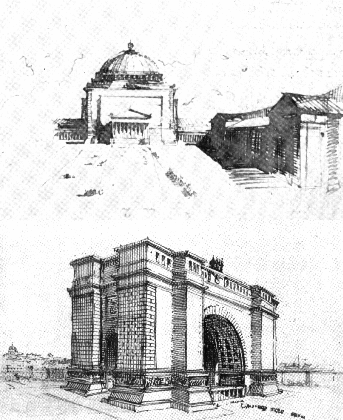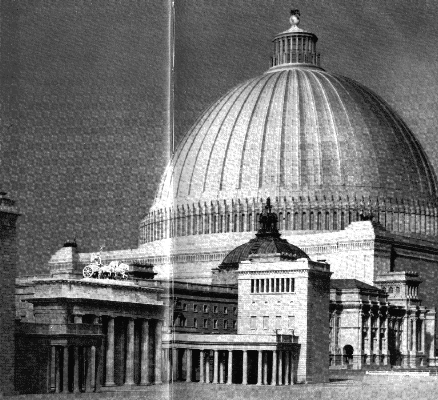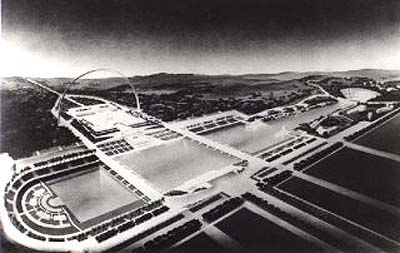
A TALE OF [TOO] MANY DOMES ....
Tony Blair is not alone in his fascination with domes. Domes have figured throughout history, in one rare form or another. So, Greenwich Dome is nothing new ? .. well, we have to admit, there's never been anything quite like it !!
Castle Howard in North Yorkshire was the first private building in England to have a dome and theirs has lasted for 300 years. Nowadays, of course, domes have never been so popular - Doncaster has one, there's one in Somerset, and I even spotted one in northern France, albeit a small one. Dome Cafes are springing up left, right and centre - what on earth is going on ?
26th October, 2000: GERMAN DOME TO CLOSE WITH £1 BILLION DEBTS
So wer'e not the only ones who can't run a party in a big tent !! Germany's World Expo exhibition in Hannover is now becoming known as Germany's biggest financial disaster in the country's history.German MPs are to start investigating the reasons for its catastrophic failure to reach targets for visitors and income. As an inquest into the five-month project gets underway, German newspaper Die Welt said " Expos finished as a disaster ... For a long time it has been clear that the Expo will make history as the biggest German planning fiasco ever". It was opened by Johannes Rau, the German President in June, and as Germany's frist Expo, it was supposed to show the country's dynamic, modern and confident face to the world, as well as intending to be a model of efficient German planning. Original visitor estimates were put at 40 million, each paying £22 per head. Having at first believed that numbers would exceed this, the organisers later admitted that Expo would run at a loss, although they believed then that it would not amount to much over £125 million. These estimates soon proved wildly optimistic (sounds familiar !) when visitor numbers were disastrously low in the first few weeks and now, five months on, the total will limp in at 17 million, less that half the original estimate. Birgit Breuel, the head of the project, has tried to put a brave face on the situation admitting that "the huge deficit was a shock for me".
At present, Expo estimates that its debt will be £750 million, but many politicians close to the project believe it will go higher because of pending legal problems with contractors who agreed to pay sums to Expo based on the original vistor estimates. Enno Hangenah, a member of the regional parliament and the Green Party's spokesman on Expo said "It will go far above this figure. When companies refuse to pay the money, as happened at previous Expos in Lisbon and Seville, then that is when the real debt will become known". The federal government has agreed to foot two-thirds of the final debt, with the other third being paid by the regional government of Lower Saxony.
Six days before the Expo closed the press office were maintaining that the project had been a triumph in all ways except money. "It has been a huge successs apart from the financial side" said a spokesman "about 95% of the people who came were remarkably happy with what they saw". Expo spin doctors are also describing it as "the biggest protocol event ever", having attracted more royals and heads of government than any other event in the world. A total of 157 countries had exhibitions at Expo, 47 more than at the last comparable exhibition held in Seville in 1992, which was regarded as the most successful ever and attracted 41 million visitors. Well, that's all right, then !
BERLIN DOME
Some of our older readers may remember grandiose plans by a certain Adolf Hitler. Architecture appealed strongly to him too, and long before he achieved power Hitler was sketching giant domes and triumphal arches for a new Berlin. The qualities which attracted him were the monumental and the massive - the architecture of the Third Reich was to reflect the power of its rulers. Sound familiar ? Hitler looked upon himself as an authority on architecture and he rebuilt both the Chancellery and his own house after he came to power. He had a passion for big rooms, thick carpets and tapestries. Sounds very familiar !! Rauschning speaks of "the familiar blend of petit bourgeois pleasures and revolutionary talk". One of these was that, just like a certain member of our own Government, he liked to be driven fast in powerful cars.Albert Speer was the young architect chosen by Hitler to build the new Reich Chancellery. As a centrepiece, Speer designed the Berlin Dome - it was to be the largest building in the world with a 250 m high dome (and have a diameter seven times that of Michelangelo's dome for St Peter's ). Berlin was to be redesigned and renamed Germania.
 |
These are Hitler's own sketches, which he made years before he and the Nazi party came to power. The top one shows the building that was meant to accommodate up to 130,000 of the party faithful, who would be paying tribute to Hitler. With a building of such a size, moisture from the breath and sweat of the audience would form rain clouds beneath the ceiling from which precipitation could occur on to the assembly. A worse dilemma was that the huge dimensions of the building would dwarf the figure upon whom all attention should be focused, Adolf Hitler. |
Speer translated Hitler's plans into the drawings below.
 |
 |
|
A close up of the proposed dome - Brandenburg Gate is on the lower left |
Of course, the Berlin Dome was never built and Speer went on to become Minister for Armaments and War Production. At the Nuremburg Trials, Speer was jailed for 20 years and on his release successfully published his memoirs of Nazi Germany and his time in Spandau Prison.
MUSSOLINI'S THIRD ROME
 |
It isn't only domes that hold fascination, almost any grandiose building scheme can meet the requirements of a vainglorious leader - Mussolini predated Hitler with building schemes for his capital city. In the 1930s-40s, aided by his favoured architect, Marcello Piacentini, Mussolini embarked on building a 'Third Rome', in a Roman suburb, to rival the Imperial and Renaissance cities. He too thought of linking his project with a celebration - in this case, an exposition, the twentieth anniversary of Fascist rule in Italy to be held in 1942. The name of the exposition was to be EUR (Exposizione Universale di Roma), or E42. Though the buildings were monumental in scale, they were in a dull and simplified classical style and involved the destruction of substantial parts of the historic centre of the city. |
The Dome. One Amazing Day. One Year Only. Thank God.